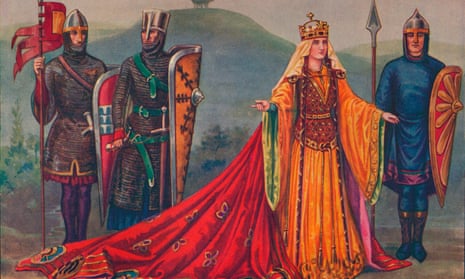In 1142 Empress Matilda escaped from Oxford Castle where she was being held by her dynastic rival, Stephen of Blois. Since it was a snowy December, the self-proclaimed “Lady of the English” wrapped herself in a white fur cloak to blend into the snowy landscape before skating down the frozen river Thames to freedom. As a bedtime story for history-mad girls, Matilda’s flight has always had everything: a heroine outtricking a boy and a nod to the enchantment of Narnia.
Catherine Hanley, though, is writing for grown-ups, and her intention in this impressive study is to remove Matilda’s cloak of invisibility – there have been remarkably few books written about the woman who was arguably England’s first regnant queen – and restore her to full subjecthood. For while Matilda never actually led her troops into battle like Jeanne d’Arc, she was present in the generals’ tent, directing the next stage in her campaign to conquer the country. She was good at the political side of things too, thanks to decades as the consort first of the holy Roman emperor Henry V and then Geoffrey of Anjou. Both rulers had depended on Matilda to run their huge heartlands while they themselves were absent for months at a time attending to their ragged borders.
By 1135, however, it was time for 33-year-old Matilda to start strategising on her own behalf. In December that year her father, Henry I (youngest son of William the Conqueror), died. Fifteen years earlier Matilda’s only brother had gone down on the White Ship, that tragic party boat that resembled nothing so much as the Bullingdon Club at sea. And although Henry had taken the precaution of nominating Matilda as his heir there were plenty of barons who balked at the idea of a female boss. Their preference was for Stephen, Matilda’s first cousin, who had the advantage of being not only a man but also a natural charmer. Matilda, by contrast, was said to take after her father, a disciplinarian who thought nothing of castrating coin minters simply for looking a bit shifty and once sanctioned cutting off the tips of his own granddaughters’ noses just to make a point.
For the next 18 years England was caught up in what historians until recently called “the Anarchy”. Matilda held the south-west, Stephen had the south-east, and the barons were happy to carve up everything that was left, which was rather a lot. “Anarchy”, though, is misleading in the way it suggests a thrilling chaos out of which something startlingly new might emerge. In fact, the years between 1135 and 1153 were more like a long war of attrition during which the country was reduced to tatters. First Matilda was captured, then Stephen was, and then they started all over again. The unrest went on for so long that even the chroniclers, a band of obsessive penmen who spent their lives writing down other people’s business, started to sound bored, as if willing everyone to hurry up and get to the end.
Eventually a surprisingly elegant compromise was reached. Matilda would cede to Stephen but he, in turn, agreed to name Matilda’s son Henry as his heir. At this point even those chroniclers who had been dead against Matilda while she was staking her claim to be a “female king” were prepared to cut her some slack. Returned to the more familiar and comfortable role of wise helpmeet, Matilda is now applauded for her prescience in warning her son, safely installed as Henry II in 1154, that Thomas Beckett might prove to be a trickier incumbent of Canterbury than anyone had anticipated. Such insight into the workings of the church were only to be expected from a woman whose grandmother was an actual saint (Saint Margaret of Scotland) and who liked to travel accompanied by the mummified hand of Saint James.
Hanley is far too experienced a reader of the medieval archive to suggest that she has somehow been able to tease out the “real” Matilda who lies hidden behind the fiercely partisan yet oddly smooth utterances of the chroniclers, for whom everyone is either very good or very bad, with little in between. All the same, within these tight constraints, she does a fine job of making the case for Matilda as a far more autonomous figure than historians have previously suggested. Laying aside the fairytale elements of the snowy escape from Oxford Castle, Hanley makes us see what a bold move it was for Matilda to claim the crown for herself. It would have been easier by far to insist on ruling as regent until baby Henry was old enough to succeed to his grandfather’s throne. But her conviction that she alone was the rightful “king” of England suggests a steeliness of purpose and self-belief that cannot be entirely contained by the flat, affectless language of the chroniclers, who insist on portraying her either as the patriotic saviour of her country or else as a pushy old dragon who should have been dispatched to a nunnery years ago.
